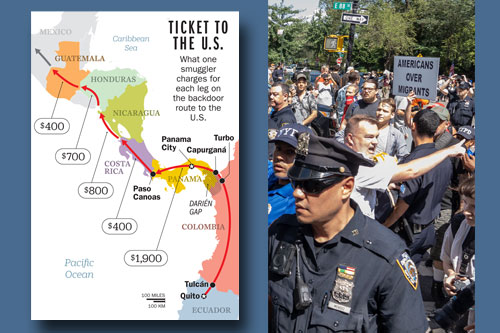Matt Bai has a lengthy portrait of DNC Chair Howard Dean in the Sunday New York Times Magazine. Bai sheds favorable light on Dean’s leadership as a champion of long-term (50 state) strategy and greater participation of Democratic “outsiders,” who have been overshadowed by “insider” consutlants. But Bai also gives fair vent to Dean’s critics, who believe his strategy will hurt Democratic chances on November 7.
And speaking of long-term strategy, WaPo’s Zachary A. Goldfarb has a short, but encouraging update on an important topic that doesn’t get enough attention from political journalists (or the DNC web pages) — the battle for control of the state legislatures, where congressional districts are defined and future candidates for congress are prepared for leadership. Goldfarb’s article, “Democrats Hope to Swing State Legislatures Their Way,” says Dems have a solid shot at winning majorities of state legislatures in Colorado, Indiana, Iowa (both houses), Maine, Minnesota, Montana, North Carolina, Oklahoma, Oregon and Tennessee.
The Daily Strategist
by Alan Abramowitz, Alben W. Barkley Professor of Political Science, Emory University
It’s déjà vu all over again. The 2006 midterm elections are only seven weeks away and the Gallup Poll likely voter screen is back to its old tricks. Last week Gallup released its first poll of the 2006 campaign using its likely voter screen and the results showed that Democrats and Republicans were tied on the generic ballot question. That’s the question that asks respondents whether they would vote for the Democratic or Republican candidate for the House of Representatives in their district if they election were being held today. The question doesn’t provide respondents with the names of the candidates—hence the term “generic ballot.” Nevertheless the generic ballot question has proven to be a fairly good predictor of the results of congressional elections once the sample is pared down to those likely to vote. But that’s not easy to do, especially more than seven weeks before Election Day.
At first glance, it might appear surprising that the new Gallup Poll found a tie on the generic ballot. After all, one week earlier another Gallup Poll produced a 12 point Democratic advantage on this question, similar to that found in most other national polls in recent weeks. But, as Charles Franklin and Mark Blumenthal recently explained, the shift from a 12 point Democratic lead to a tie wasn’t really as dramatic as it seemed. It was almost entirely a result of the introduction of the likely voter screen. Among all registered voters, the new Gallup Poll found a 9 point Democratic lead on the generic ballot.
Almost all polling organizations use some sort of likely voter screen to measure voting intentions shortly before an election. This is especially critical in a midterm election in which, historically, only about 40 percent of eligible voters go to the polls. However, the Gallup likely voter screen is more complicated than most—it involves a series of seven questions including one that measures current political interest. As a result, while it appears to work quite well in the last day or two before an election, it can produce highly volatile results when applied several weeks before an election. During the 2000 election campaign, for example, Gallup’s presidential preference results sometimes gyrated wildly over the course of only a few days—on October 4th, Gallup showed an 11 point lead for Al Gore. Three days later, on October 7th, they showed an 8 point lead for George Bush. However, much of this apparent volatility was caused by the likely voter screen rather than actual shifts in candidate preference among voters.
Some of the volatility in Gallup’s results in 2000 may have been caused by their use of a tracking poll with a 3-day rolling sample. Tracking polls tend to be more volatile than standard polls because they allow less time for callbacks. During the 2004 campaign, however, Gallup’s likely voter screen sometimes produced large swings in candidate support over relatively short time periods. For example, between October 10th and October 16th, Gallup reported a shift from a 2 point Kerry lead to an 8 point Bush lead. In contrast, the CBS/New York Times Poll found a 1 point Bush lead on October 11th and a 1 point Bush lead on October 17th and a Time Magazine Poll found a 1 point Bush lead on October 7th and a tie on October 15th.
Why does Gallup’s likely voter screen produce greater volatility in candidate support than likely voter screens used by other polls? The answer is not clear but a reasonable guess would be that it has to do with the use of a question asking about a respondent’s current level of political interest. Political interest may vary considerably depending on what types of news stories are making the headlines. When the President delivers a major address to the nation for example, supporters of his party are likely to be more interested in news about the speech than supporters of the opposing party. In the final days before an election, interest in the campaign and knowledge about where one’s polling place is located are probably good predictors of voter turnout. Seven weeks before an election, however, these questions may not predict turnout very well.
The 9 point gap between registered and likely voters in Gallup’s recent generic ballot results appears overly large by historical standards. Don’t be surprised to see the gap close by the end of the campaign. In the meantime, however, don’t be surprised to see big fluctuations in the results of Gallup’s generic ballot question among likely voters.
It’s hard to get focused on long-range political goals so close to elections. But there is a good article noted in the ‘hump day’ wrap-up below that political strategists should grab and save. Search far and wide — you won’t find a better analysis of the need for a greater investment in Democratic youth leadership development than Iara Peng’s Alternet article “How Progressives Can Win in the Long Run.” Peng’s challenge:
For nearly 30 years, ultraconservatives have invested hundreds of millions of dollars in young people and built an infrastructure that initiates young people into the radical right movement through campus activism, leadership training and career development. Their investments have paid off. The radical right wing now controls the executive and legislative branches of government, and it’s only one seat away from complete dominance of the Supreme Court.
If progressives want to achieve the same sort of political success that the radical right has enjoyed for the past two decades, we’re going to have to do more than focus on the next round of elections and pay lip service to engaging young people. We must make a serious, long-term investment in our next generation of progressive leaders.
Yes, Dems have their own youth leadership training programs. But can they match this?
For decades, right-wing organizations including the Leadership Institute, Federalist Society, Cato Institute and Heritage Foundation have spearheaded a massive effort to bring young people into their movement. Last year alone, the Right invested $48 million in 11 youth-focused organizations aimed at increasing the number of ideologically friendly campus papers, fostering networks of students on campuses, shifting the way that students self-identify in terms of political ideology, providing skills and strategies training, and promoting right-wing values.
Students are cultivated by the right-wing campaign against college courses that conflict with their agenda. For example, they have accused more than 100 professors of making “anti-American” statements. They attend courses with titles like “How to Stop Liberals in Their Tracks.” They have internships, fellowships and jobs waiting for them when they graduate. They learn how to run campaigns and how to run for office.
…Right-wing groups spend more than ten times as much on long-term political leadership development than we do, and financial trends over the past four years show that progressive leadership development organizations are actually, on average, experiencing a decline in revenue.
And the pay-off has been impressive. As a result,
A powerful network of young ultraconservatives fills state capitols, the halls of Congress, the executive branch and the courts. It is supported by community leaders, skilled organizers, academics and media personalities that help dominate the debate. The leaders in whom the right has invested in are familiar names. In 1970, a man named Karl Rove was head of the National College Republicans. In 1981, Grover Norquist took the reins. And in 1983, it was Ralph Reed.
Peng offers some credible corrective measures, and there are some good comments responding to her challenge. Clip her article, read it and consider making a contribution for the long haul.
by Scott Winship
Check out this very cool interactive website summarizing key House races, courtesy of Constituent Dynamics and RT Strategies. Good polling of House races are hard to find. I’m hoping to find out how many more rounds of polling they plan to do.
Six weeks before election day political strategy articles are multiplying like guppies. Greenberg Quinlan Rosner addresses an important and frequently overlooked topic of interest to Dems — increasing the turnout of unmarried women voters (Executive Summary here and PDF Memo here)…Alternet has a pair of political strategy must-reads: George Lakoff’s “12 Traps That Keep Progressives from Winning” and Iara Peng’s “How Progressives Can Win in the Long Run,” a precription for correcting the left’s comparatively weak efforts for youth leadership development…Chris Bowers has a very encouraging wrap-up of House races at MyDD showing 40 seats “in serious play”…NYT’s Adam Nagourney reports on the escalating use of nasty attack ads in congressional campaigns, while Janet Hook focuses on GOP attack ads in the L.A. Times…WaPo‘s Amit R. Paley reports on two polls — one by the U.S. State Department — that show a large majority of Iraqis want U.S. forces to leave pronto…Harold Meyerson’s WaPo op-ed shreds the “moderate Republican” myth…In These Times contributing editor Hans Johnson reports on the rapidly rising tide of GOP politicos switching to the Democratic party…As the focus sharpens on congressional races, don’t forget that there are many important ballot initiatives across the nation. Swing State Project references 194 ballot propositions in 32 states (Summary here) and R. Neal takes a look at some of them in his Facing South article “Ballot Initiatives around the South.”…Arthur I. Blaustein’s Mother Jones call-to-arms “Campaign 2006: The Issues, the Stakes, the Prospects” provides a shot of political adrenalin for progressives.
by Scott Winship
I’ve spent a bit of time reading some polls today with an eye toward saying something brilliant about the likely results of the elections. I have to say that I’m inclined to agree with Ezra Klein that national polls on congressional approval tell us very little.
Ezra notes that congressional approval rates were in the low 50s in 1990, when the (majority) Democrats picked up seats, 56% in 1994 when they lost a ton of seats, and 64% when they — as the minority party — won seats. I’d add that according to the NYT/CBS poll [pdf] Ezra examines, the share saying their own Representative deserves re-election is down from 1998 and 2002 to its 1994 level, but it was also as low in 1990 when the (majority) Democratic Party picked up seats.
One survey question that is intriguing, however, asks which candidate for one’s congressional district a person would vote for if the election were held today. According to the table on p. 13 of the pdf, the tally on this question in the final poll before the election correctly predicts the party that picks up seats in the ’94, ’98, and ’02 elections. By that rule of thumb, the Democrats look in good shape — they lead 50-35 in the most recent poll, which is the biggest lead found in the NYT/CBS poll between 1994 and today.
However, the table also shows that there are sizeable swings in the last month before elections. One would have predicted that the Dems would pick up seats in ’94 based on the September and October polls and that they would pick up seats in ’02 based on the early October poll. That means that, well, anything can happen in the next month.
Still, things look pretty good from 30,000 feet. It’s true that the percent saying that the economy or jobs is the most important issue has declined steadily since 2003, from one-third of Americans in October of that year to 11% today. Furthermore, the percent of Americans saying terrorism is the most important issue is at 14%, the highest level since prior to mid-2003. And a number of issues on which Democrats are advantaged are irrelevent: just 3-4% of Americans say health care is the most important issue, 1-2% say politicians and government, 1-2% say the environment, and 3% say the heating oil/gas crisis – down from 14% in May.
However, throughout 2006, 22-23 percent of Americans have said that Iraq or “war” is the most important problem, and the Democrats are favored on this issue. The elections are going to be about the unpopularity of Iraq and the salience of the terrorist threat. Control of the House will hinge exclusively on which party wins this battle, and Republicans look awfully weak. But again, anything can happen….
The Republican strategy of characterizing Democratic candidates as “soft on terrorism” just suffered a damaging if not lethal blow in the form of a leaked “National Intelligence Estimate.” The report reflects “U.S. intelligence community’s first formal evaluation of global trends in terrorism since the April 2003 invasion of Iraq,” according to Washington Post reporters Michael Abramowitz and Jonathan Weissman. The authors say “the report concludes that the Iraq war has fueled the growth of Islamic extremism and terror groups.”
In his article “No Silent Majority for Bush,” WaPo columnist E. J. Dionne, Jr. notes further:
…News over the weekend of a National Intelligence Estimate on Iraq is especially troublesome for Republican electoral chances. By finding that the war in Iraq has encouraged global terrorism and spawned a new generation of Islamic radicals, the report by 16 government intelligence services undercuts the administration’s central argument that the Iraq war has made the United States safer.
Nor is there any way to dismiss the assessment as partisan, left-wing or unpatriotic. That high-level government officials have offered their own criticisms of the war’s impact makes it difficult for Republicans to force the argument into a classic “he said-she said” framework in which facts can be set aside and the claims of critics dismissed as political.
Meanwhile a new CNN/Opinion Research Corp. poll conducted 9/22-24, indicates that 59 percent of Americans oppose the Iraq war and 55 percent of likely voters said they would vote for a Democrat if the election were held now, compared to 42 percent for a republican.
There will be a lot more said and written about the leaked report over the next seven weeks. But it’s clear that the “soft on terrorism” label the GOP has tried to pin on Dems so frequently now has “backfire” written all over it.
In nation-wide polls ranking the political priorities of voters, foreign trade rarely scores very high. Indeed the issue is often submerged in voter concerns about “the economy.”
But trade is a major issue this year in key congressional and state-wide elections, reports Molly Hennessy-Fiske in today’s L.A. Times. Hennessy-Fiske focuses on Democratic convert Jack Davis’s campaign to unseat Republican Thomas M. Reynolds from his western NY district as a marquee campaign with trade as a pivotal issue, and she provides an interesting run-down of how the issue is playing out at the state and district level:
With wages stagnating for many Americans, trade has become a significant campaign factor this fall in parts of New York, Pennsylvania, Georgia and other states. In Ohio, Michigan and North Carolina, where manufacturers continue to shutter plants and cut jobs, free trade has become a major issue of campaigns.
In Michigan, Democratic Sen. Debbie Stabenow, who is seeking reelection, recently ran a TV ad highlighting her effort to create a “trade prosecutor” to investigate unfair foreign competition.
In Ohio, Republican Sen. Mike DeWine and his Democratic challenger, Rep. Sherrod Brown, have repeatedly sparred over trade, with Brown calling for “fair-trade” policies that hold foreign companies to U.S. workplace standards.
In North Carolina, Republican Rep. Robin Hayes, a textile heir, is under attack from his opponent, a former textile worker, for supporting the Central American Free Trade Agreement last year. Hayes cast the deciding vote
Trade is an issue that clearly has GOP candidates dodging and equivocating, particularly with working-class voters. Democratic candidates who successfully articulate strong “fair trade” arguments in districts hit hard by job losses to foreign trade may have the edge that leads to victory on November 7.
by Scott Winship
This week we closed out our Missing the Middle roundtable with a final response from Third Way. I’m also happy to report that today a new article went up on our homepage. “Authoritarianism and the American Political Divide,” by political scientists Jonathan Weiler and Marc J. Hetherington, shows that the extent to which people hold authoritarian child-rearing attitudes predicts their political preferences. Not only that, but when the perceived threat from some development — say, terrorism or gay marriage — the preferences of anti-authoritarians tend to move toward those of authoritarians. Check out this important article, and let us know what you think.
With 47 days to go before the mid-term election, Democrats have a 15 point lead over Republicans among registered voters in a generic vote for congressional representatives, according to a New York Times/CBS News poll conducted 9/15-19. As Adam Nagourney and Janet Elder explain in their NYT poll summary:
In the poll, 50 percent said they would support a Democrat in the fall Congressional elections, compared with 35 percent who said they would support a Republican….In one striking finding, 77 percent of respondents — including 65 percent of Republicans — said most members of Congress had not done a good enough job to deserve re-election and that it was time to give a new people a chance. That is the highest number of voters saying it is “time for new people” since the fall of 1994.
But Elder and Nagourney warn that Dems should temper their expectations because of several factors:
But the poll found that Democrats continued to struggle to offer a strong case for turning government control over to them; only 38 percent said the Democrats had a clear plan for how they would run the country, compared with 45 percent who said the Republicans had offered a clear plan…Democrats face substantial institutional obstacles in trying to repeat what Republicans accomplished in 1994, including a Republican financial advantage and the fact that far fewer seats are in play…Most analysts judge only about 40 House seats to be in play at the moment, compared with over 100 seats in play at this point 12 years ago, in large part because redistricting has created more safe seats for both parties.
Still, Democrats can be encouraged by the fact that 43 percent of respondents said they were “more enthusiastic” about voting on November 7. In addition, Dems have narrowed the GOP advantage on addressing terrorism to 5 percent, according to the poll.









